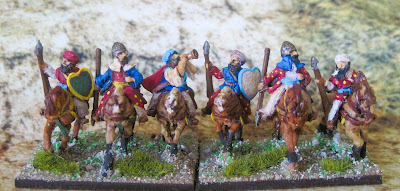The Andalusian nobility were well motivated and skilled
warriors. Very well mounted and compared to Christian Hidalgo more lightly
protected. More your swift javelin throwers who can hit and evade. Actually,
many Hidalgos fought just like that. What gave them the edge and all
agree they had it, was the Christian fondness for a decisive charge.
Steady close formed foot could be reduced with missilery
rather than immediately charged head on.
This all makes sense to me. The lessons are easily absorbed. Things to do, things to avoid.
Things take a turn for the worst when we consider the
infantry of Al Andalus. The skirmishers
were not the best but they could and would skirmish. It was the close order
infantry that everyone thought was markedly inferior. Their only edge was
sartorial it seems. Man for man they seem to have been wealthier than their
foes. Below Berber Warriors.
I don’t know why this disparity should have been so marked. It
may be that the mounted element of the Andalusian Armies was descended from the
professional soldiers of the original conquering Arab Army. Perhaps the
infantry were comprised of the descendants those who arrived later or had
converted for better conditions. I have a couple of books coming that may shed
some light.
Whatever the cause, attempts were made to effect redress.
The easiest was to employ steady mercenaries-expensive. The other was to adopt
the crossbow. The Andalusians did both.
There was sound reasoning for the Papal Ban on the crossbow. It could kill better skilled and protected warriors from a relatively safe distance. In terms of the order of society promoted by Frankish Christianity the crossbow was a serious threat to the establishment. That was a world where Nobles Fought, Clerics Prayed and everyone else worked. Where would that World be if the peasants could kill the nobles before the nobles killed the peasants?
I’m going to give my Andalusians two crossbow units. They
won’t have high morale but they will shoot hard.
The mercenaries could be Christian warriors, or Berbers or
the Soldiers of the defunct Caliphate of Cordoba. The latter could be Slavs or
Sub Saharan Africans who had been enlisted on the Mamluk model. All of the
forgoing were capable fighters. Importantly, Christian knights could be and
were hired to deliver the missing deadly charge.
Above, you see my Andalusians and their mercenaries so far.








A very interesting read OB, really enjoyed it a colourful army on the table, very nice work on your units.
ReplyDeleteThanks Donnie.
DeleteMore nice figures and informative text OB - I had heard previously that the cross bow was very "frowned upon" for the reasons stated - we find it amusing today (I speak for myself) but they were deadly serious at the time - the idea that some jumped up peasant in third rate leather armour could sit with impunity on a castle wall and kill a duke, earl or even king, was anathema to the people who ran society!
ReplyDeleteThanks Keith. Yeah, one of those revolutionary moments in military matters. A bit like Swiss peasant pikemen. Everything changed.
DeleteWhen I did my Reconquista project I had real issues with understanding what the Andalusians/Almoravids were doing. All the sources that are readily accessible are western Christian based. I have all the David Nicolle Ospreys, and Ian Heath's Armies of the Middle Ages and so on, and I don't see how the people writing wargaming guides and army lists are getting from the sources to their published conclusions. Add to that the fact that many of the Christian sources are misleading, being derived from Biblical precedents rather than actual events. Mind you, I enjoyed painting the figures, and it looks like you did too.
ReplyDeleteGood points Graham and I don't know enough to do them justice. I'm half way through Fletcher at the moment.
DeleteI don't have a problem with the light horse/Jinete thing. For either side. Cantabrians, Visigoths, Moors all liked to ride fast and throw javelins.
Harder charging cavalry for the Christians? Obviously a Frankish influence and we can note that was running high in Christian Spain. The Spanish Liturgy had just conformed to the Frankish model.
On the infantry I'm less certain. Lots of javelins for sure. But what of the bow among the Berbers and Andalusians. An Arab influence? Some of the earliest info' we have on the Arab Conquests involves a description of mailed mounted archers. Not Persians either.
I'll keep researching and I did enjoy painting these fellows.
BTW, your blog no longer comes up on a search. I'll stick a link in the sidebar for ease of access.
Great work OB, luvvly paintjob!
ReplyDeleteCheers Ray.
Delete